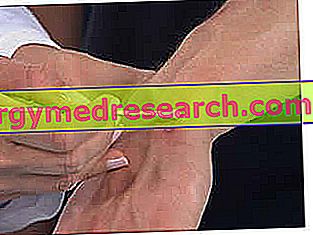Generality
The signs of an insect bite represent the result of the injection of poison or other substances in the skin; the severity of the reaction and the appearance of symptoms depend on individual sensitivity to these substances.

Management
How to handle mild reactions to insect bites
Most insect bites and bites cause itching and swelling, signs that usually resolve spontaneously within a few hours. The purpose of the treatment is to alleviate the unpleasant and particularly annoying symptoms even more quickly.
Minor reactions can be treated as follows:
- In case of bee sting, remove the sting to avoid further spread of the poison;
- Wash the affected area with soap and water;
- Apply a cold pack over the area to reduce swelling and pain;
- Try not to scratch the surface of the wheal and the neighboring area, to avoid infection of the damaged skin (keep the children 's nails short and clean);
- It is also possible to use valid herbal remedies, such as the local application of Aloe (gel or pulp) or an Calendula based ointment, to soothe the skin area tip from the insect.
If the puncture is rather painful or the swelling affects an extended region, it is also possible to resort to an additional treatment :
- Prepare a pack by wrapping some ice cubes in a towel and place it on the affected area;
- Apply a topical cream to relieve pain and relieve itching. Creams containing ingredients such as hydrocortisone, local anesthetics (lidocaine or pramoxine) or antihistamines can help control pain. Other creams (example: calamine lotion) can soothe itchy skin.
- On medical advice it is possible to take painkillers, such as paracetamol or ibuprofen, or antihistamines, to reduce swelling.
- If the local swelling is severe, the doctor may prescribe a short course of oral corticosteroids, such as prednisolone, to be taken for 3-5 days.
- If the itching and redness of the damaged skin deteriorates or does not tend to resolve after a few days, it is advisable to consult your doctor.
Bee sting
Sting removal
Bee stings can produce different reactions, ranging from temporary pain to severe allergic reaction (anaphylaxis).
How to intervene:
- The first and most important thing to do in case of a bee sting is to remove the sting as quickly as possible; as recent studies show, it is important to do this within the first 20 seconds of contact with the insect, no matter how, the important thing is to act quickly. A few seconds of delay, even if related to the intent to implement the most appropriate removal method (for example by extracting a credit card from the wallet), would lead to a greater release of poison, therefore greater damage. For this reason it is recommended to intervene quickly, without paying too much attention to the sting extraction technique. In any case, it is worth remembering the useful recommendations to prevent further spread of the poison:
- be careful not to break the blister that contains it and that may have been released into the skin along with the sting.
- Better to avoid the use of tweezers, as it can cause bladder rupture. The ideal is to use a blunt blade that makes the sting jump, but even an object with a rigid edge, such as a credit card, could work.
- Alternatively, you can proceed with your hands: after having washed them, use two fingers lightly pressing around the bladder, such as when you are pressing a pimple
- Once the sting is removed, make cold water compresses and apply cortisone-based creams several times a day until the symptoms disappear.
Wasp or hornet bite
Wasps and hornets do not leave the sting in the victim and can sting repeatedly. If you have been stung and the insect is still in the area, move very calmly to a safe area to avoid further bites.
How to intervene:
- After the puncture it is sufficient to clean the area well with water and soap, then disinfect lacutes.
- Slide cold water over and around the puncture to obstruct inflammation, or apply ice to relieve pain.
- To combat pain and itching it is useful to make cold water packs and possibly apply an antihistamine or cortisone cream.
- If the swelling tends to extend further, you should contact your doctor.
Mosquito bites
Hematophages such as mosquitoes, which sting to feed, inflict one or more bites in the exposed areas of the body and produce papules or wheals, similar to bubbles. The components of the saliva of these insects trigger a slight reaction of the immune system that causes itching, swelling and redness, at each puncture. Most injuries heal spontaneously without requiring special medical treatment. Against itching, the most annoying symptom, you can resort to compresses with cold water or ice; if necessary, an antihistamine ointment can be applied at the puncture site for about 2-3 days.
Tick bite
During a walk in the woods or in the meadows, you can come across this small arachnid. In general, the tick causes only one sting, which is recognized by the presence of a red dot in the center of the papule. To reduce the risk of contracting an infection, such as Lyme disease (a bacterial infection that causes a characteristic rash), it is advisable to remove the tick as soon as possible, grasping it and turning it gently with tweezers. Do not use oils, petrolatum, alcohol or gasoline, which can damage it and favor the passage of germs. Most tick bites heal within three weeks. If after four or five days the reaction tends to worsen (the lesion increases in size and becomes lighter in the center), and a rash associated with fever develops, it is essential to seek medical attention. With the puncture, in fact, a disease may have been transmitted which must be treated with appropriate antibiotics.
Skin bubbles
If blisters or blisters develop due to an insect bite, it is important to resist the temptation to burst them because they can easily become infected. If possible, use a plaster and a soft, sterile dressing to protect the area until the signs are resolved.
Infected stings
Secondary infection may occur in the days following the bite or sting of the insect. This condition can be facilitated by giving in to the temptation to repeatedly scratch the itchy skin flap. Even during the puncture, some pathogenic microorganisms can be transmitted into the body.
The signs of infection manifest themselves with:
- Increased redness, swelling or pain;
- Presence of purulent material (pus) around or within the injured area;
- Swollen lymph nodes (small glands that are part of the immune system);
- Occurrence of flu-like symptoms.
Secondary bacterial infections are a common complication of insect bites. In general, they can be treated with oral antibiotics, to be taken according to medical prescription, indicatively for seven days.
Management of allergic reaction
Allergic reactions to insect venom generally occur within a few minutes. If an insect bite causes a severe or anaphylactic reaction, urgent medical intervention is required.
- In the event that generalized symptoms occur, in areas of the body that are very far from the site of the puncture, contact the doctor or the emergency room immediately.
- An insect bite can potentially induce an anaphylactic shock: in this case it may be necessary to administer an adrenaline injection to reduce the systemic allergic response. Generally, highly allergic patients always carry this life-saving drug with them.
- The emergency treatment for allergic reactions may include the administration of antihistamines and intravenous cortisone, to reduce the inflammatory reaction, make the airways open and thus improve breathing. For the same purpose oxygen can be provided to the patient, to help compensate for limited breathing, and a beta-agonist (such as salbutamol) to relieve respiratory symptoms. Potentially fatal airway obstruction generally manifests as hoarseness, a persistent cough and glottal edema.
- If the allergy to insect bites is overt, the doctor could decide to prescribe to the patient an epinephrine autoinjector (a pen charged with self-injectable adrenaline, which represents a portable life saving drug) and indicate how to use it correctly in emergency conditions.
- In the case where previous insect bites cause an extended skin reaction, such as redness and swelling above 10 cm in diameter, the doctor can recommend immunotherapy (desensitization therapy), as a possible treatment option in case of allergy to injections 'insect (most commonly wasp or bee). The purpose of treatment is to desensitize the body to prevent further serious reactions to future insect bites.
Infestations
Different types of fleas, mites and bedbugs can infest pets, furniture, bedding etc. These tiny arthropods can cause recurrent punctures, which manifest themselves with itchy spots or blisters. However, due to their small size, many people do not realize that this "rash" is caused by an insect; consequently, they are led to believe that they are suffering from some other dermatological disease.
How to intervene:
- If insect bites are common, try to identify the source of the infestation and take steps to eliminate it.
- To resolve infestations, it is useful to ask your veterinarian for advice, as aggressive treatment with suitable insecticides is often required, which can control pests without harmful effects on the pet. For example, it is possible to intervene with a targeted treatment if you suspect that your pet is infested with fleas.
Prevention
How to prevent insect bites
There is a whole range of behaviors and precautions to be taken to minimize the risk of being bitten or stung by an insect:
- Insects generally become more aggressive during the summer, as it represents the season of maximum reproduction. The places most at risk are pools of water, such as ponds and marshes: water, heat and humidity, in fact, are ideal conditions for their development. In situations that may be at risk, wear long sleeves and pants. Mosquitoes and horseflies are commonly found near water.
- Usually, insects mostly affect exposed and uncovered areas of the body, such as arms, legs and hands. It is therefore advisable to cover yourself adequately if you do outdoor activities or at a time of day when insects are particularly active, such as at sunset in the case of mosquitoes.
- Never disturb hives or insect nests.
- If you are surrounded by a swarm, move away very slowly, without panicking or waving your arms. Do not try to crush the insects, as the sudden movements alert them making them more aggressive.
- Identify the possible presence of wasp nests or hornets in the garden or at home and have them removed as soon as possible. Wasps prefer to live in sheltered areas between trees and between roof spaces. Always contact professionals to remove bee or wasp nests.
- Never walk outdoors with bare feet: if you crush a bee or a wasp, the animal reacts by pricking.
- Stay away from flowers, trees, bushes, waste bins and woodpiles, which can attract insects. Avoid picking ripe fruit from the ground or trees; the more mature they are (rich in sugar), the more likely they are to harbor insects; for example, ripe grapes strongly attract wasps
- Insects, but especially wasps, love to buzz around food. Store uneaten food covered when eating outdoors. In particular, do not leave open canned drinks, as they attract insects. Wash your hands after eating or handling sweet foods outdoors (advice especially for children).
- Avoid strong perfumes, cosmetics and highly perfumed sunscreen. Dress preferably with light-colored clothing, as bright or dark colors attract insects.
- Insect repellents, to be applied on the body and on clothing, are effective against horseflies and mosquitoes, but do not seem to work as well for hymenopterans (bees, wasps, hornets).
- If possible, provide mosquito nets with doors and windows to prevent insects from entering the house.
Protect yourself when traveling abroad
Before traveling to areas with a high risk of infection from insect bite diseases, it is important to be aware of all the risks and take appropriate precautions. For this purpose it is useful to consult the doctor before leaving, to have any drug or vaccine necessary to reduce the possibility of contracting an infectious or parasitic disease (example: antimalarial prophylaxis if traveling in Africa, Asia and South America).
Some suggestions help protect against insect bites and the diseases they transmit:
- Avoid traveling to places where there is an outbreak of disease;
- Organize activities in order to avoid times of day and places that expose you to a greater risk of being points or bites;
- Protect your skin by wearing long-sleeved clothing, hats and boots, and applying insect repellent on your clothes to prevent insects from reaching your skin;
- At the end of the day, carefully inspect the clothes and skin to identify any ticks;
- Sleep under a mosquito net and consider the use of repellents and insecticides, as well as alternative products that repel insects from the room where they stay.



